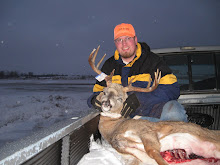This winter has not been kind to the wildlife. The snow is so deep in most places that it is almost impossible for wildlife to find food. Species such as pheasants, deer, bighorn sheep, and pronghorn are all affected by the depth of the snow. According to the North Dakota Game and Fish Department, “Reports of pheasant losses continue, especially after the statewide rain experienced in early February. “Reports across the state vary from birds doing okay to areas with considerable losses,” said Stan Kohn, upland game bird supervisor. “In some instances, landowners are reporting 75 percent fewer birds than they did in the beginning of winter.”” The Game and Fish Department has a video about what is going on with the pheasants. It is called “Winter’s Effects on Upland Game Birds.”
Deer are also having a difficult time surviving during this winter. The Game and Fish Department “continues to receive reports of dying or dead deer in some areas of the state. Kreil said mostly fawns and older deer are affected by the cold and wind, which is not uncommon. In addition, heavy snow cover that prevents deer from accessing their usual food sources has resulted in at least five separate incidents of grain overload, with seven to 50 deer dying in each incident. Dr. Dan Grove, wildlife veterinarian, said grain overload is a result of deer overeating on corn and/or other grains. “Their diet typically consists of grasses and browse; they are not adapted to indulge only on corn, wheat and oats,” Grove said. “But with the constraints they have this winter, this is what food is readily available to them.”” Another video the Game and Fish Department has is “Winter’s Effect on Wildlife.”
Bighorn sheep are also having a hard time with the winter conditions. A representative from the Game and Fish Department states, “We recently documented the loss of six mature radio-collared bighorn sheep in the northern badlands due to exposure and severe winter weather,” said Brett Wiedmann, big game biologist. “These are big, hearty animals that should survive North Dakota winters, but apparently the severe conditions got the better of them.”
Pronghorn are another species that have been affected by the severity of the winter. According to the Game and Fish Department, “While there hasn’t been any winter-related mortality of pronghorn documented yet, Bruce Stillings, big game biologist, said there is little doubt they are in a vulnerable state due to deep snow, and in some cases have limited movement because herds are prevented from moving south of Interstate 94. “One of our biologists saw a herd of 200 pronghorn belly-deep in snow, and other large groups have been observed bunched together north of Belfield and east of Dickinson,” he added. “This is not a good situation. It is nearly impossible for them to cross the interstate and migrate to areas with less snow.””
This winter has not been a good one for wildlife. Unless the weather starts getting better there may be a major loss in population size of pheasants and deer. The snow cover prevents deer and pheasants from reaching their normal food sources. Without those normal food sources deer and pheasants are forced to find other sources of food. This takes them away from their normal habitat and closer to farmsteads where readily available food can be found.
From Article: Winter Wildlife Woes Continue
Friday, March 13, 2009
Subscribe to:
Comments (Atom)
